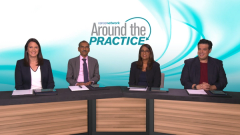
Future Directions: Novel Targeted Therapies in Multiple Myeloma
A comprehensive review of novel therapy being investigated in the setting of relapsed/refractory multiple myeloma to expand the bispecific antibody and CAR T-cell therapy armamentarium.
Episodes in this series

Transcript:
Sundar Jagannath, MD: One of the other things I wanted to understand about bispecifics is that you can have several targets. Could you tell us what the different targets are in the clinical trial?
Joshua Richter, MD: Right now the main bispecifics that we have all utilize CD3 on 1 of their arms to activate the Tcells. At our institution [Mount Sinai Hospital, New York, New York], we currently have 4 targets that are located on the tumor cells. BCMA [B-cell maturation antigen] is the most far along, but we have 3 others, including GPRC5D [G protein-coupled receptor class C group 5] with a drug called talquetamab, which will hopefully be approved in 2023. [Also a] target called FcRH5 [Fc receptor-like 5], [with] a drug called cevostamab, which is probably going to take until 2025 to get approved; and then CD38, the daratumumab target. We have that as well, [but it] is a little further down the pike. The wonderful thing is that all of these markers are expressed independently in the plasma cells. So, you can actually go from one to the other. And some of the great work by our physicians, including Tarek Mouhieddine, Oliver Van Oekelen, and Samir Parekh, has demonstrated the ability to give these therapies sequentially and reactivate the Tcells.
Sundar Jagannath, MD: OK, you told us that 1 arm binds to CD3. I guess you are activating T cells, but are there any studies activating the NK [natural killer] cells?
Joshua Richter, MD: There are a number of trispecifics that are being looked at, including the TriNKET study [NCT04975399], which is looking into activating NK cells. Many of these are very early on and we do not know yet how this is going to pan out. We do know that as patients relapse in myeloma, their NK cell population tends to decrease. So, it is unclear to me if these are going to win out and, much like all of our therapies, are going to be a lot more active earlier on.
Sundar Jagannath, MD: Then as always you are doing CAR [chimeric antigen receptor] T-cell therapy, which is an approved treatment. What is life after CAR T? Since it is not necessarily curative, and if the patient relapses, and these are all anti-BCMA CAR T, what are some of the options available, Dr Rossi?
Adriana Rossi, MD: Sticking within our wheelhouse, I think other CAR Ts are similar to the bispecifics in that you have different targets. We now have studies looking at GPRC5D as an alternative target and a couple of others that are still up and coming. But to Dr Richter’s point, we do have data that our group has presented showing that you can go after BCMA from a bispecific or CAR T or vice versa. So, it doesn’t seem that that loss of antigen is really the mechanism of resistance for most of our patients. Continuously going after the T cell seems the most effective way to salvage patients after CAR T, although, as we saw, we have a number of other triplets, and none of them seem to be quite as robust.
Sundar Jagannath, MD: Dr Richard, we just heard Dr Richter rattle off several other targets for bispecific antibodies. So, if a patient fails a BCMA-directed bispecific antibody, can they just roll over, and are they supposed to respond when they are [beginning] on the bispecific antibody against BCMA? Would that T cell be exhausted or will they respond if you switch the target?
Shambavi Richard, MD: I think so much of this is not known yet, and we are doing a lot of translational work in the lab on T cells for these details. Some of the things we know are that sequential applications of CAR Ts and bispecifics seem to have good results, better than if you just use some other kind of alternative treatment, and colleagues from our institution presented that. But, also, intuitively, we know that the majority of the relapses are happening with BCMA being expressed still, meaning we are not losing the antigen, unlike something that is from the lymphoma literature. However, it makes sense to switch up the target so that we are not attacking the same target. We have other options now. We have a GPRC CAR T option. We certainly have other options for bispecifics, so that might be something I would prefer to do if I have that option. Secondly, I think as the CAR NKs start rolling along—they are much farther back in the pipeline—that might be another thing to address. Then there will be the multiplicity of targets that we now have with those. Maybe a few more complications, maybe shorter timed infusions, and these things may be as much of a deterrent as they are currently.
Transcript edited for clarity.
Newsletter
Stay up to date on recent advances in the multidisciplinary approach to cancer.





















































































